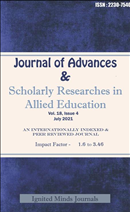The Development of a Creative and critical thinking education method for Primary School Teachers
Empowering Primary School Teachers with Creative and Critical Thinking Education
Keywords:
creative and critical thinking education method, primary school teachers, thought processes, verbalism, memory, information technology, reading skills, analytical thinking, synthetic thinking, global collaborationAbstract
Teaching to develop thought processes is the opposite of teaching to fix automatic responses.Learning without thinking critically becomes memorization. A pupil can 'recite' accurately withoutunderstanding what he is saying. Verbalism is often mistaken for thinking. Some teachers tend to overemphasizememory. A large number of the grades given to children are based upon their ability toreproduce certain facts from memory. The emphasis is on memorizing of material. Humans have to liveamong a variety of information technology and news that could be obtained conveniently and fast. As aresult, various incidents were perceived throughout time as a result of reading, listening, and watching.As a result, human development for good reading skills leading to thinking processes in dimensions ofanalytical thinking, synthetic thinking, or critical thinking was required to transform human resources'quality into high potentiality in all aspects, as well as readiness for creative adjustment and globalcollaboration. It fit within the 21st century's conceptual framework for learning. Thinking was the processof using one's intellect as a tool for learning, contemplating, and assessing what was good and wrong.Many instructors stressed the importance of thinking capacity, saying, Every step of the learningprocess ought to be centered on students' critical thinking training. The majority of knowledge offeredin the classroom, as well as memorization from textbooks, deprived pupils of experience, criticalthinking, and experience synthesizing for greater wisdom. The globalization movement has broughtboth good and evil. As a result, the educational process should assist pupils in gaining information,thinking, and correct cognition, as well as learning how to change them. Critical Thinking was verysignificant since it was deliberate thinking used for carefully examining and judging the occurringinformation or circumstance based on one's own knowledge, reasoning, and experience in carefullyexploring the evidences in order to arrive at logical conclusions. As a result, critical thinking became asymbol of self-worth because it was a fundamental requirement for educational management.Downloads
Download data is not yet available.
Published
2021-07-01
Issue
Section
Articles
How to Cite
[1]
“The Development of a Creative and critical thinking education method for Primary School Teachers: Empowering Primary School Teachers with Creative and Critical Thinking Education”, JASRAE, vol. 18, no. 4, pp. 446–451, July 2021, Accessed: Jan. 11, 2026. [Online]. Available: https://ignited.in/index.php/jasrae/article/view/13267











